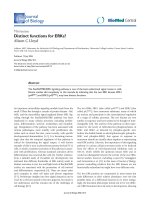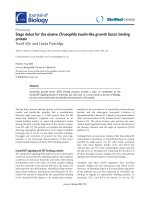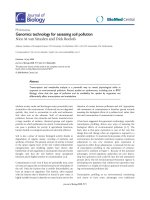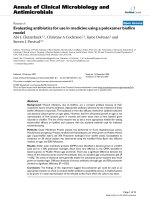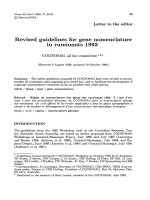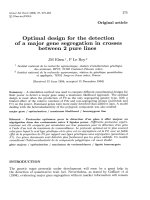Báo cáo sinh học: "Latitudinal clines for alcohol dehydrogenase allozymic variation and ethanol tolerance in Indian populations of Drosophila ananassae" docx
Bạn đang xem bản rút gọn của tài liệu. Xem và tải ngay bản đầy đủ của tài liệu tại đây (466.8 KB, 12 trang )
Original
article
Latitudinal
clines
for
alcohol
dehydrogenase
allozymic
variation
and
ethanol
tolerance
in
Indian
populations
of
Drosophila
ananassae
R
Parkash
Shamina
Maharshi
Dayanand
University,
Department
of Biosciences,
Rohtak,
124001,
India
(Received
17
June
1993;
accepted
18
November
1993)
Summary -
Eight
Indian
geographical
populations
of
D
ananassae,
collected
along
a
20°N
latitudinal
range,
revealed
significant
clinal
variation
at
the
Adh
(alcohol
dehydrogenase)
locus
and
Adh
F
allelic
frequency
increased
by
about
1.5%
with
1°
latitude.
Latitudinal
increase
of
ethanol
tolerance
(1.8-3.7%)
was
observed
in
adults.
Survival
studies
with
adults
showed
that,
in
all
cases,
ethanol
was
used
as
a
resource
at
low
concentrations,
while
becoming
a
stress
at
higher
concentrations.
The
resource/stress
concentration
threshold
increased
from
1.2
to
4%
with
latitude.
Larval
behaviour
also
exhibited
an
attraction/avoidance
threshold,
increasing
from
1.6
to
4.4%
ethanol
with
increasing
latitude
of
origin.
The
parallel
occurrence
of
latitudinal
variation
at
the
Adh
locus
and
ethanol
tolerance
and
utilisation
in
natural
populations
of
D
ananassae
could
be
maintained
by
balancing
the
natural
selection,
which
varies
spatially
along
the
north-
south
axis
of
the
Indian
sub-continent.
Drosophila
ananassae
/
Adh
polymorphism
/
ethanol
utilisation
/
larval
behaviour
1
latitudinal
cline
Résumé -
Clines
de
latitude
pour
la
variation
allozymique
de
la
déshydrogénase
alcoolique
(Adh)
et
la
tolérance
à
l’éthanol
dans
des
populations
indiennes
de
Drosophila
ananassae.
Huit
populations
géographiques
indiennes
de
D
ananassae,
récoltées
sur
une
étendue
de
20
degrés
de
latitude
nord,
ont
révélé
une
variation
clinale
significative
au
locus
Adh
(déshydrogénase
alcoolique),
et
une
augmentation
de
la
fréquence
de
l’allèle
Adh
F
d’environ
1,5
point
de
pourcentage
par
degré
de
latitude.
Une
augmentation
de
la
tolérance
à
l’éthanol
avec
la
latitude
(de
1,8
à
3,7%)
a
été
observée chez
les
adultes.
*
Correspondence
and
reprints:
446/23
(Near
Park),
DLF
Colony,
Rohtak,
124001,
Haryana,
India.
Les
études
de
survie
sur
adultes
ont
montré
que,
dans
tous
les
cas,
l’éthanol
est
utilisé
comme
une
ressource
lorsqu’il
est
à de
faibles
concentrations,
alors
qu’il
devient
un
facteur
de
stress
à
des
concentrations
élevées.
Le
seuil
entre
ressource
et
stress
se
situait
entre
1,2
et
4%
selon
la
latitude.
Le
comportement
larvaire
a
aussi
montré
un
seuil
d’attraction/évitement,
augmentant
de
1,6
à
4,4%
d’éthanol
avec
l’augmentation
de
la
latitude
d’origine.
Le
parallélisme
observé
entre
les
variations
du
locus
Adh
et
la
tolérance
à
l’éthanol
et
son
utilisation
dans
les
populations
naturelles
de
D
ananassae
en fonction
de
la
latitude
pourrait
être
la
conséquence
d’une
sélection
naturelle
équilibrante
variant
dans
l’espace
le
long
de
l’axe
nord-sud
du
sous-continent
indien.
Drosophila
ananassae
/
polymorphisme
de
l’Adh
/
utilisation
de
l’éthanol
/
comporte-
ment
larvaire
/
cline
de
latitude
INTRODUCTION
Colonising
species
populations
offer
the
most
suitable
material
for
microevolution-
ary
studies
(Endler,
1977;
1986).
Eight
Drosophila
species
are
known
as
truly
cos-
mopolitan
while
21
Droso
P
hilia
species
have
been
designated
as
widespread
(David
and
Tsacas,
1981).
Studies
on
biogeography
and
evolutionary
history,
chromosomal
and
allozymic
polymorphism,
ecological,
behavioural
and
quantitative
traits
were
made
in
the
colonising
populations
of
D
melanogaster
but
such
studies
are
lacking
for
most
of
the
successful
colonising
and
widespread
drosophilids
(David
and
Tsacas,
1981;
David
and
Capy,
1988).
D
ananassae
constitutes
one
of
the
most
successful
colonising
and
domestic
species
of
the
Indian
sub-continent
and
was
first
described
by
Doleschall
(1958)
from
Indonesia.
Chromosomal
polymorphism
has
been
exten-
sively
studied
in
Indian
natural
populations
of
D
ananassae
(Singh,
1984a,b;
1989),
but
studies
on
characters
such
as
enzyme
polymorphism
or
physiological
traits
are
totally
lacking.
To
fill
this
gap,
we
have
investigated
Adh
(alcohol
dehydrogenase)
polymorphism
and
ethanol
tolerance
in
this
species.
D
ananassae
was
found
to
ex-
ploit
a
variety
of
fermenting
fruits
in
nature
and
larvae
were
observed
physically
immersed
in
fermented
media.
Since
Adh
is
known
to
be
involved
in
the
utilisation
and
detoxification
of
exogenous
alcohols,
the
present
studies
were
made
in
order
to
analyse
the
extent
of
genic
divergence
at
the
Adh
locus
as
well
as
ethanol
tolerance
in
D
ananassae
populations
from
India.
MATERIALS
AND
METHODS
D
ananassae,
a
member
of
the
D
melanogaster
group
in
the
Sophophora
subgenus,
is
a
successful
colonising
species
throughout
the
Indian
sub-continent.
Isofemale
lines
were
established
from
population
samples
of
D
ananassae
from
8
Indian
geographical
sites
(Rameswaram
to
Saharanpur;
9.17°N
to
29.58°N,
figure
1).
Data
on
the
number
of
isofemale
lines,
which
were
maintained
for
5-6
generations
in
the
laboratory,
are
given
in
table
I.
Homogenates
of
single
individuals
(one
fly
per
isofemale
line)
were
subjected
to
electrophoresis
at
250
V
and
25
mA
at
4°C
for
4
h.
The
gel
slices
were
stained
for
the
Adh
gene-enzyme
system
by
a
standard
staining
procedure
(Harris
and
Hopkinson,
1976).
Genetic
control
of
Adh
banding
patterns
was
interpreted
from
the
segregation
patterns
of
enzyme
electromorphs
of
parents,
F1
and
F2
progeny
of
several
single-pair
matings.
The
adult
ethanol
tolerance
was
assessed
following
the
longevity
test
of
Starmer
et
al
(1977).
In
order
to
test
ethanol
utilisation,
groups
of
10
males
or
females,
grown
on
killed
yeast
medium,
were
aged
for
2
d
on
fresh
food
medium
and
then
transferred
to
a
set
of
2
air-tight
plastic
vials
which
contained
different
ethanol
concentrations
(1-7%).
All
experiments
were
run
in
5
replicates
at
20°C
and
control
experiments
employed
water
in
place
of
ethanol
solution.
Adult
survivorship
was
monitored
by
daily
observations
of
control
and
ethanol
treatment
experiments.
The
LT50
values
were
calculated
as
the
number
of
hours
at
which
50%
of
the
flies
had
died
and
were
estimated
by
linear
interpolation.
The
ethanol
resource
utilisation
values
were
represented
by
the
ratio
LT50
ethanol/LT
So
control,
ie
if
this
ratio
was >
1,
ethanol
was
utilised
as
a
resource,
but
if
this
value
was
<
1,
it
represented
stress.
The
ethanol
threshold
concentration
was
obtained
when
LT50
ethanol/LT
SO
control
was
equal
to
1.
The
larval
behaviour
towards
ethanol
was
analysed
by
following
the
method
of
Gelfand
and
McDonald
(1983).
The
relative
numbers
of
the
larvae
out
of
a
total
of
10
on
the
2
sectors
of
agar
Petri
dishes
(with
and
without
ethanol)
were
noted
after
20
min
for
each
ethanol
concentration.
Five
replicates
were
tested
at
each
ethanol
concentration
at
20°C
for
each
D
ananassae
population.
The
threshold
values
between
attraction
and
avoidance
after
20
min
were
then
calculated.
RESULTS
Genetic
basis
of Adh
polymorphism
The
Adh
enzyme
in
D
ananassae
revealed
a
single
cathodal
zone
of
activity.
Segre-
gating
2-banded
patterns
(of
either
faster
or
slower
mobilities)
and
4-banded
pat-
terns
of
Adh
were
observed
in
the
individuals
of
D
ananassae.
Genetic
crosses
in-
volving
different
2-banded
patterns
resulted
in
4-banded
patterns
in
F1
individuals,
and
1:2:1
ratio
of
segregating
2-banded
and
4-banded
patterns
in
the
F2
progeny.
Thus,
Adh
electrophoretic
data
of
the
parents
and
progeny
of
genetic
crosses
was
found
to
be
in
agreement
with
a
monogenic
control
of
Adh
patterns.
The
homo-
zygous
individuals
exhibit
a
2-banded
pattern
and
the
observed
Adh
electromorphs
correspond
to
post-translational
or
conformational
isozymes.
The
present
observa-
tions
correspond
to
what
has
been
known
for
Adh
for
a
long
time
in
D
melanogaster
and
other
species.
Latitudinal
Adh
allozymic
variation
The
data
on
Adh
allelic
frequencies
in
8
Indian
populations
are
given
in
table
I.
The
Adh
frequency
increased
significantly
with
increasing
latitude
(1.5%
with
1°
latitude,
r
=
0.92).
The
Adh
locus
revealed
significant
interpopulation
genotypic
heterogeneity
(141.07)
and
allelic
frequency
heterogeneity
(33.3)
on
the
basis
of
contingency
chi-squared
tests
among
the
Indian
populations.
The
data
on
Wright’s
fixation
index
(FST
=
0.21)
revealed
significant
genic
divergence
at
the
Adh
locus
in
Indian
populations.
Thus,
the
allelic
frequency
patterns
at
the
Adh
locus
revealed
significant
clinal
variation
(along
the
south-north
axis)
among
Indian
populations.
Ethanol
utilisation
by
adults
The
D
ananassae
adults
were
analysed
for
their
potential
to
utilise
ethanol
vapours
in
a
closed
system
and
the
data
from
8
geographical
populations
of
D
ananassae
are
given
in
figures
2
and
3.
Adult
longevity
was
found
to
increase
in
the
range
of
1
to
2%
ethanol
in
south
Indian
populations
while
1-4%
ethanol
revealed
enhanced
longevity
in
the
north
Indian
populations
(fig
2).
The
data
revealed that
the
south
Indian
population
of
Rameswaram
had
a
longevity
of
141
h
compared
with
the
north
Indian
population
of
Saharanpur
in
which
it
was
175
h.
However,
the
other
6
geographical
populations
revealed
intermediate
values
(table
II).
The
data
on
LT50
ethanol/LT
50
control
(which
constitute
the
measure
of
resource
versus
stress)
are
shown
in
figure
2.
The
adult
ethanol
threshold
values
were
found
to
vary
clinally
in
the
range
of
1.2
to
4.0%
among
the
8
populations
from
south
to
north
of
the
Indian
sub-continent
(table
II).
Thus,
ethanol
concentration
in
the
range
of
3.4
to
4.0%
served
as
a
resource
for
north
Indian
populations
while
significantly
lower
ethanol
concentrations
(1.2-2.8%)
could
be
utilised
by
south
Indian
populations
of
D
ananassae.
ethanol
tolerance
In
5
Indian
populations
of
D
ananassae
that
could
utilise
ethanol
as
a
resource
up
to
1.5%
longevities
were
compared
at
1%
ethanol
and
the
data
revealed
interpopulational
divergence
(fig
4a).
The
toxic
effects
of
ethanol
concentrations
were
observed
from
mortality
data
on
the
4th
day
of
ethanol
treatment
of
adults
and
LC50
values revealed
clinal
variation
from
1.8
to
3.7%,
ie
southern
populations
of
D
ananassae
displayed
significantly
lower
ethanol
tolerance
than
the
north
Indian
populations
(fig
4b).
Larval
behaviour
The
data
on
larval
behaviour
towards
a
range
of
concentrations
of
ethanol
(1-6%)
are
represented
in
figure
5
and
table
II.
The
larval
ethanol
threshold
values varied
from
1.6%
in
the
Rameswaram
population
to
4.4%
in
the
Saharanpur
population.
The
ranking
order
of
populations
is
Saharanpur
>
Rohtak
>
Nagpur
>
Pune
>
Tirumala
>
Madras >
Tiruchchirappalli
>
Rameswaram.
The
larval
individuals
of
8
populations
of
D
ananassae
revealed
higher
ethanol
tolerance
than
those
of
adults
but
the
pattern
of
clinal
variation
was
found
to
be
similar
for
both
the
adult
and
larval
stages
(table
II).
The
ethanol
indices
in
larval
and
adult
individuals
were
found
to
vary
latitudinally
in
all
8
populations
of
D
ananassae
(fig
5).
The
statistical
correlations
were
found
to
be
significantly
higher
among
latitudinal
variation
versus
larval
and
adult
ethanol
tolerance
(table
III).
The
Adh-F
allelic
frequency
also
revealed
significant
correlation
with
latitude.
Thus,
ethanol
tolerance
seems
to
be
adaptively
maintained
by
natural
selection
mechanisms.
DISCUSSION
The
present
data
on
clinal
variation
at
the
Adh
locus
in
Indian
populations
of
D
ananassae
further
supported
and
validated
the
hypothesis
that
occurrence
of
latitudinal
clines
among
geographical
populations
provides
strong
evidence
of
natural
selection
maintaining
such
clinal
allozymic
variation
(Nagylaki,
1975;
et
al,
1982).
The
observed
latitudinal
variation
in
D
ananassae
concurred
with
other
reports
on
the
populations
of
D
melanogaster,
ie
US
populations
(Marks
et
al,
1980;
Van
Delden,
1982);
Australian
populations
(Oakeshott
et
al,
1982);
and
European
and
African
populations
(David
et
al,
1986).
The
observed
data
on
D
ananassae
could
be
explained
on
the
basis of
the
niche-width
variation
hypothesis,
ie
the
amount
of
variation
in
a
species
was
proportional
to
the
niche-width.
It
has
been
argued
that
a
species
characterized
by
utilisation
of
diverse
food
resources
and/or
climatic
adaptations
should
possess
a
significantly
higher
amount
of
genic
divergence
compared
with
narrow
niche-width
species
(Parsons,
1983;
Spiess,
1989).
The
Indian
geographical
populations
of
D
ananassae
revealed
significant
genetic
divergence
in
their
potential
to
utilise
ethanol.
Adult
longevity
was
found
to
increase
significantly
when
ethanol
increases
from
1
to
2%
for
south
Indian
populations
and
from
1
to
4%
for
north
Indian
populations
of
D
ananassae.
The
ethanol
threshold
values
were
found
to
vary
clinally
in
the
range
of
1.2
to
4.0%
in
the
case
of
adults
and
1.6
to
4.4%
for
larvae
in
geographical
populations
of
D
ananassae
from
south
to
north
localities.
The
LC50
values
revealed
a
clinal
variation
in
the
range
of
1.8
to
3.7%
ethanol,
ie
southern
populations
displayed
lower
ethanol
tolerance
than
the
northern
populations.
The
ethanol
tolerance
threshold
values
in
larval
and
adult
individuals
were
found
to
vary
latitudinally
in
different
Indian
populations
of
D
ananassae.
The
present
observations
are
in
agreement
with
other
reports
on
the
evidence
of
action
of
natural
selection
at
the
Adh
locus
as
well
as
for
ethanol
tolerance
in
some
allopatric
populations
of
D
melanogaster
(Hickey
and
Mclean,
1980).
Thus,
both
these
traits
have
adaptive
significance
and
are
maintained
by
natural
selection
mechanisms.
ACKNOWLEDGMENTS
Financial
assistance
from
CSIR,
New
Delhi
is
gratefully
acknowledged.
We
are
grateful
to
the
reviewers
for
their
helpful
comments,
JR
David
for
his
valuable
guidance
in
the
present
studies
and
M
Weber
for
drawing
the
figures.
REFERENCES
David
JR,
Capy
P
(1988)
Genetic
variation
of
Drosophila
melanogaster
natural
populations.
Trends
in
Genetics
4,
106-111
David
JR,
Mercot
H,
Capy
P,
Mcevey
SF,
Van
Herrewege
J
(1986)
Alcohol
tolerance
and
Adh
gene
frequencies
in
European
and
African
populations
of
D
melanogaster.
Genet
Sel
Evol 18,
405-416
David
JR,
Tsacas
L
(1981)
Cosmopolitan,
sub-cosmopolitan
and
widespread
species:
different
strategies
within
the
Drosophila
family.
CR
Soc
Biogeog
57,
11-26
Doleschall
CL
(1958)
Dende
Leijdrage
tot
de
kennis
den
dipteren
fauna
van
Nederlandsh
Incie.
Nat
Tijd
Nederla!d
India
17,
73-128
Endler
JA
(1977)
Geographic
Variation,
Speciation
and
Clines.
Princeton
Univer-
sity
Press,
Princeton,
NJ
Endler
JA
(1986)
Natural
Selection
in
the
Wild.
Princeton
University
Press,
Princeton,
NJ
J
Gelfand
JL,
McDonald
JF
(1983)
Relationship
between
alcohol
dehydrogenase
(ADH)
activity
and
behavioral
response
to
environmental
alcohol
in
five
Drosophila
species.
Behav
Genet
13,
281-293
Harris
H,
Hopkinson
DA
(1976)
Handbook
of
Enzyme
Electrophoresis
in
Human
Genetics.
North-Holland,
Amsterdam
Hickey
DA,
Mclean
MD
(1980)
Selection
for
ethanol
tolerance
and
Adh
allozymes
in
natural
populations
of
D
melanogaster.
Genet
Res
36,
11-15
Marks
RW,
Brittnacker
JG,
McDonald
JF,
Prout
T,
Ayala
FJ
(1980)
Wineries,
Drosophila
alcohol
and
Adh.
Oecologia
47,
141-144
Nagylaki
T
(1975)
Conditions
for
the
existence
of
clines.
Genetics
80,
595-615
Oakeshott
JG,
Gibson
JB,
Anderson
PR,
Knibb
WR,
Anderson
DG,
Chambers
GK
(1982)
Alcohol
dehydrogenase
and
glycerol-3
phosphate
dehydrogenase
clines
in
D
melanogaster
on
different
continents.
Evolution
36,
86-96
Parsons
PA
(1983)
The
Evolutionary
Biology
of
Colonising
Species.
Cambridge
University
Press,
Cambridge,
London,
New
York,
pp
1-261
Singh
BN
(1984)
High
frequency
of
cosmopolitan
inversions
in
natural
populations
of
D
ananassae
for
Kerala,
South
India.
J
Hered
75,
504-505
Singh
BN
(1984b)
Genetic
distance
in
inversion
polymorphism
among
natural
populations
of
D
ananassae.
Genetica
64,
221-224
Singh
BN
(1989)
Inversion
polymorphism
in
Indian
populations
of
D
ananassae.
Hereditas
110,
133-138
Spiess
EB
(1989)
Genes
in
Populations.
John
Wiley
and
Sons,
New
York
Starmer
WT,
Heed
WB,
Rockwood-Sluss
ES
(1977)
Extension
of
longevity
in
D
mojavensis
by
environmental
ethanol:
Differences
between
subraces.
Proc
Natl
Acad
Sci
USA
74,
387-391
Van
Delden
W
(1982)
The
alcohol
dehydrogenase
polymorphism
in
D
melanogaster.
Selection
at
an
enzyme
locus. Evol
Biol 15,
187-222

